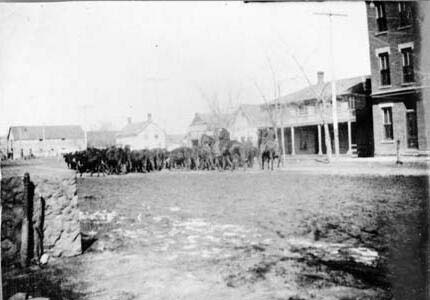News Flashbacks
1880 Drought Recalled By Pioneer Harvey H. Griffin
Fort Collins Coloradoan, Thursday, July 1, 1954

There's been talk heard lately to the effect that this year's drought is "the worst in local history." Harvey H. Griffin, whose residence here dates from 1884, remembers at least two periods of pioneer times in which local residents were as hard hit by natural disaster as many stockmen and farmers this year.
Mr. Griffin has written The Coloradoan about the drought of 1879-80 which disastrously affected the cattle industry at that time. He also recalls, as a boy living on a farm near Brighton, seeing effects of the grasshopper plague of 1873, which lasted three years. Grasshoppers, he says ate all the live vegetation in sight, and clustered so thickly on a shovel handle that it could not be seen.
Ansel Watrous' History of Larimer County records that the plague came hard on a bank failure which "absorbed most of the money in the county." Grasshopper swarms left the country "destitute of food and the means to obtain it. Many became discouraged and left the country. Since 1876 the country has not been troubled with these migratory pests and not an entire crop failure has occurred." Mr. Griffin, now 87, retired in 1928 as agriculture superintendent here for the Great Western Sugar Co. He was one of Colorado A & M College's graduating class of 1888. He is a former chairman of the county Democratic Central Committee. His letter follows: A headline in the papers recalls to my mind a condition very similar to the present: "Gov. Thornton thinks the drought may drive out the cattle industry."
The drought in the winter and spring of 1879 and 1880 did actually drive out the cattle industry, and Colorado never did regain that loss in a similar manner. Colorado at that time was a "cattle country" in every sense of the term; vast herds roamed the prairies and the owners were not aware of how many they owned. Only once or twice a year did they come in contact; that was at roundup time. There was a concerted movement in spring and fall by the cattleman who would drive all the cattle together in a limited area and the owner would select his for branding of calves and marketing.
The winter of 1879 and 1880 was much like the one just past, and the drought continued into the spring and summer, well into July. Nearly all the range men gathered their herds in May and June to move into Wyoming, Nebraska, Kansas and other places where pasture was available. Some sold outright. I know of one man who did, receiving $22 a head for all but calves. A few men refused to move or sell, preferring to take the chance on nature righting things. I can remember one in particular, Ben Twombly of Fort Lupton. Late in July and August rain came in abundance. Gramma grass grew so that hay could be cut over much of the area that was as dry as our hills are now. The few cattle that were left eked out substances so that but few died until the rains relieved the drought.
From this time the irrigation interests became the order of the times. Herds began to get attention rather than drift over the prairies year 'round . In the 75 years that have passed since then we have seen many dry years, many that have given the farmer anxiety. But in none have we lost so heavily that fairly good results have not been obtained. I surmise that in 1925 came the nearest, but even that year June came largely to our rescue. This year so far has largely duplicated that of 1880; but here is hoping that the conditions that rescued that year may yet do the same so that all will not be as total a loss as some fear. There is yet time for much help to alfalfa to beets, corn and beans and ranges. That is what happened in 1880 but farming was different then.


Preserving the history of Fort Collins, Colorado & the Cache la Poudre region





